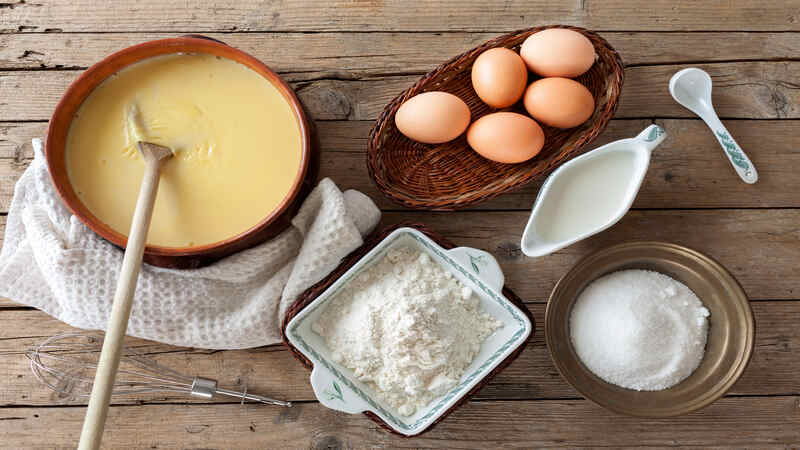
Custard combines milk and egg, which is heated to create a thick cream. Custard originated in Germany and was paired with steak. The ingredients for making custard include milk, eggs, flour, sugar, and flavored essence (1). Babies love the taste of custard. But how good is custard for babies?
Once babies start solids at 6 months, parents have to constantly brainstorm on safe and easily digestible foods that help a baby grow and develop (2). Parents have to understand which foods are safe and unsafe for babies. This article discusses the time to introduce custard to babies, its benefits, and side effects.
Video of Introducing Custard to Babies
Is It Safe to Give Custard to My Baby?
Yes. It is entirely safe to give custard to your baby. Custard is quite delicious and babies love eating it. The preparation process makes it easy to digest for babies (3).
As babies cross 6 months of age, their energy requirements increase and they need nutrition-dense foods that will satisfy their appetite and encourage growth and development (4).
So, you can give custard to an active baby. If your little one has not started moving from place to place through crawling, running, or walking, you should wait for them to start their movement phase.
Is Custard Good For My 6 Months Baby?
Yes. Custard improves eyesight, helps maintain brain health, and gives many more health benefits to your little one.
Babies lose their excitement in liquid food when they turn four months old. Most babies show readiness for solids by the time they are around 6 months old by getting rid of tongue thrust and developing reasonable head control.
This is the time when they can be put in the highchair. You can give them various flavored custards, including bananas, oats, checkers, birds, vanilla (5) and more. Choose the right one for your little one.
[Read: Baby And Solid Foods: When And How to Introduce]
Can a 9 Month Baby Eat Custard?
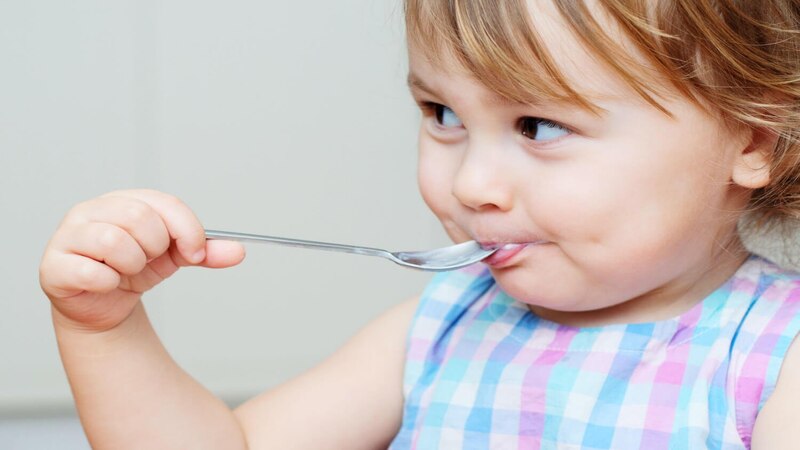
Yes. Custard is suitable for your baby, but you must have portion control. Custard is sweetened and you must not give it often to your 9 month old baby . The egg custard is more delicious, and a 9-month-old can find it exciting.
Is Custard Good For My One Year Old Baby?
Yes. Custard is undoubtedly good for a one year old. But, it is also important to note that making them a full meal often is not recommended.
Custard can be an occasional treat but not a regular meal as they do not meet the daily nutrient requirement of the babies (6).
Further, since there are high levels of sweeteners, it is better not to offer custard very often to your babies (7).
Does Custard Make Babies Fat?
A bowl of egg custard is a delicious addition to a baby’s meal that provides extra energy due to its high fat and sugar content. Babies fed frequently in large portions can gain weight and develop dental rotting.
Homemade custards with a sweet and creamy texture are perfect for babies since they are easily digestible. You also know the quantity and quality of the ingredients, ensuring there is no added sugar, fat, or preservatives while making custard for your little one. Give them a nutritious, pleasant special surprise they’ll like!
Amazing Benefits of Custard For Babies
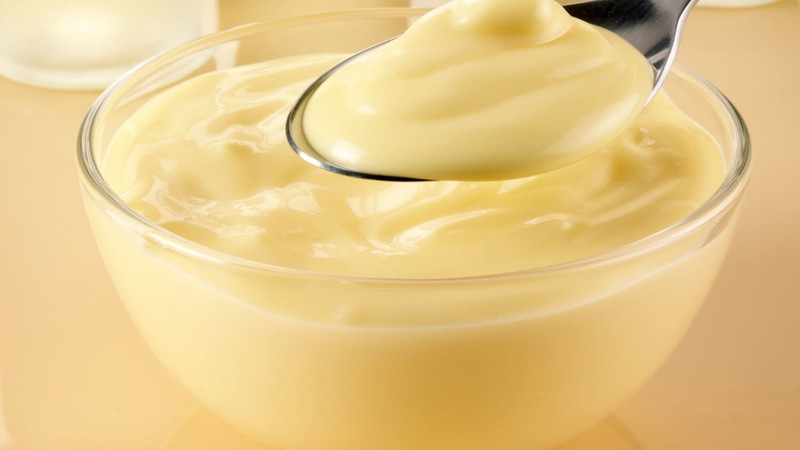
Custard is a delicious dessert at the end of the meal. If your little one has started enjoying the solids and can easily swallow food, they will love the custard.
More than being delicious, there are several benefits that custard can offer to your little one. Custards help your baby to meet age-appropriate weight goals.
Again, it is essential to note that what kind of custard you use determines the extent of benefits, for instance. If you use custard powder, do not expect your baby to gain weight.
Custard made by combining eggs and milk gives your baby a good weight. So, the fat pockets for your little one depend on the kind of custard you are giving them.
The following are some of the benefits of custard custard for little ones.
- Key components include full milk and egg, making this an excellent source of protein.
- Aids bone health by providing a considerate amount of calcium.
- Gives excess fat and energy due to the presence of sugar.
- Helps fight fatigue.
- Improves eyesight.
- Makes the baby feel fuller for a long time.
- Reduces the risk of arthritis and cancer.
- Helps improve brain health.
- Gives a glowing skin.
- Prevents and fights against anemia.
- Made from corn starch, it is gluten-free. This may help babies with gluten or Celiac sensitivity issues meet their nutritional needs
Side Effects of Custard For Babies
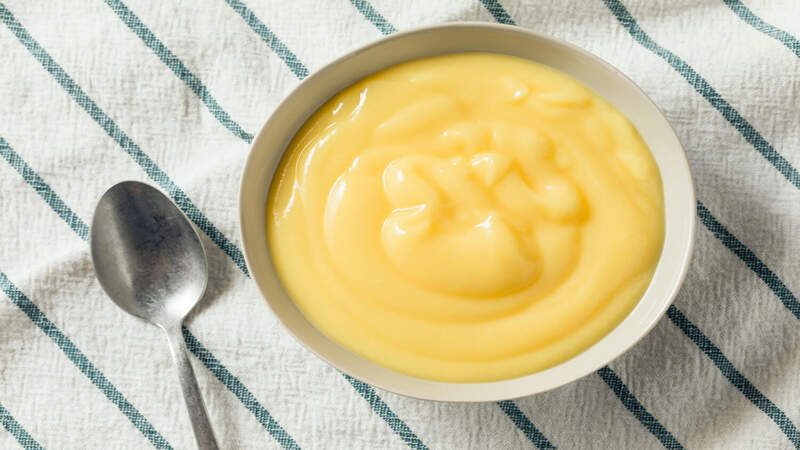
Custard has the potential to cause side effects among babies.
Custard poses a health risk since it can promote microbial development and, if contaminated, cause foodborne illness. Cross-contamination (S. aureus, E. coli, or coliforms) can occur during the preparation stage of the cold custard mix, and once made, the custard is not refrigerated (8).
The following are some of the side effects of custard for your babies.
- Custard contains common food allergens such as milk and eggs.
- Eating custard may cause spikes in blood sugar levels
- Excess sugar can result in early diabetes if the custard is consumed frequently.
- Though weight gain can be beneficial, too much weight can make your baby obese. Keep a check on the quantity and frequency of custard consumption.
- Custard is made of milk and eggs. It is not suitable for babies who are lactose intolerant.
Homemade custard is always better than store-bought ones as they don’t contain preservatives and other artificial flavors and colors (9).
Custard is one of the best foods if consumed once in a while. Frequent consumption can result in excessive weight gain and other heart diseases.
[Read: Lactose Intolerance In Babies]
Top 4 Tasty And Healthy Custard Recipes For Babies
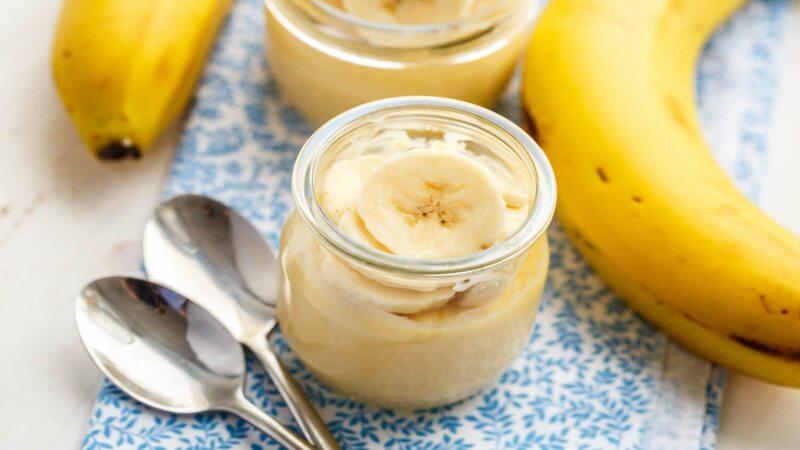
Custard can be one of your baby’s infrequent friends to kindle their taste and interest in food. Here are some easy ways to prepare and offer custard to your babies.
1. Eggless Vanilla Custard
The eggless Vanilla Custard can be offered to babies over 6 months. It contains milk, brown sugar, rice flour, vanilla extract or bean, banana, and mango puree.
You can blend the rice flour, brown sugar, and vanilla extract with the milk and bring to a boil until it forms a creamy layer. Refrigerate the mixture and offer it to your kids with mango or banana puree whenever you give them.
Is it not so quick and easy? Further, it also contains good fat and other nutrients required for your baby. You can also add some nuts for older kids.
2. Banana Custard
Banana Custard is a blend of Banana and custard made of egg and milk. You can include a drop of vanilla extract to give a good flavor. Ensure to use the mashed bananas and not whole ones.
Babies who refuse to eat bananas will love the banana custard. You can also use any other fruit puree instead of banana for your little one.
3. Oats Custard
Oats custard can be given to babies who are over 8 months old. You can use boiled eggs, jaggery powder, and cinnamon powder to the custard to make the dish rich and tasty.
Ensure to use homemade custard with eggs and milk. You can also use dry fruit powder to make a thick and creamy custard.
4. Homemade Fruit Custard
You can also make fruit custards by combining, blending or topping the basic custard with a selection These handmade custards could serve as a nutritious and healthful choice for your babies. Here are some types that you can try for your munchkin.
- Coconut and Apple Custard
- Mango and Passion fruit Custard
- Baked Custard
- Eggless papaya and cinnamon Custard
You can use rice flour, potato or sweet potato starch for the eggless custard to give the creamy texture.
Custard for babies is a bundle of nutrients and fat that can help your baby’s growth and development. But remember, the bundle shall be an infrequent taste kindler rather than the regular visitor. Happy Parenting!
FAQ’s
1. Is Custard Powder Healthy For Babies?
No. Custard Powder is made of corn flour and is a shortcut to making effortless and quick custard at home. While it does not have the fattening ability, it is not considered healthy as it contains a lot of sweeteners and preservatives.
2. What is Custard Powder Made of?
Custard powder contains cornflour or cornstarch, salt and other artificial flavorings. If you do not like eggs, then custard powder is a blessing in disguise.
3. Which is Healthier, Custard or Yogurt For Babies?
Yogurt is a healthier option than custard. It contains a lot of bacteria and probiotics that improve babies’ gut health. For babies older than 6 months, you can offer unflavored and unsweetened yogurt.
4. Is Custard Porridge Good For Babies?
Yes. Custard, a delectable spoonable porridge, is a fantastic occasional baby treat.
5. What Age Can Babies Eat Custard?
Always introduce custard only to babies who have started solids. Usually 8 month mark is a good time to start this dessert. Be mindful of the ingredients and ensure your baby is not allergic to them when introducing custard to your munchkin.
6. Can a Year-old Baby Take Custard?
Yes, babies who have turned a year old can have custard. This dessert is a very good source of protein and other nutrients provided it is made correctly. Moderation is key since excess consumption can cause undue weight gain.
References
- Maximizing Benefit of the Components of Custard Powder from Natural Sources – [https://www.researchgate.net/publication/351578997_Maximizing_Benefit_of_the_Components_of_Custard_Powder_from_Natural_Sources]
- Adherence to Infant Feeding Guidelines in the First Foods New Zealand Study – PMC – [https://www.ncbi.nlm.nih.gov/pmc/articles/PMC10647304/]
- Influence of heat treatment and egg matrix on the physicochemical and allergenic properties of egg custard – PubMed – [https://pubmed.ncbi.nlm.nih.gov/32078753/]
- The big squeeze: a product content and labelling analysis of ready-to-use complementary infant food pouches in Australia – PubMed – [https://pubmed.ncbi.nlm.nih.gov/37024884/]
- >A review on nanomaterial-based electrochemical sensors for determination of vanillin in food samples – PubMed – [https://pubmed.ncbi.nlm.nih.gov/36041662/]
- Quality attributes and consumer acceptability of custard supplemented with Bambara groundnut protein isolates – ScienceDirect – [https://www.sciencedirect.com/science/article/pii/S2772502222000166]
- Nutritional Aspects of Commercially Available Complementary Foods in New Zealand Supermarkets – PubMedhttps://pubmed.ncbi.nlm.nih.gov/33003388/
- Microbiological quality of Portuguese custard tarts in Toronto—a pilot study – [https://pubs.ciphi.ca/doi/10.5864/d2017-019]
Read Also: My Baby’s First Ice Cream
